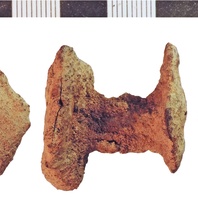
Viking Objects
Clench Nail (NLM-2FC690)
Clench nails were used in clinker-style ship-building from the 7th century to the 15th and also for domestic purposes, in which clench nails might appear where ship timber has been reused. Clinker ship-building involved building the ship’s hull first out of layered planks attached to the keel and held together using clench nails. Clinker-built boats and ships are particularly associated with the Vikings.
Read More
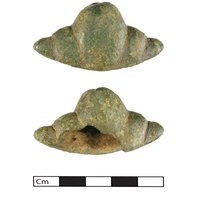
Viking Objects
Sword Pommel (NARC-E7AAF4)
An Anglo-Scandinavian copper-alloy sword pommel classed as a Petersen L type VI. The design is a fusion of Anglo-Scandinavian and Anglo-Saxon fashions. In many cases the design of the sword pommel is the only method of identifying the possible type and date of the sword it was attached to.
Read More
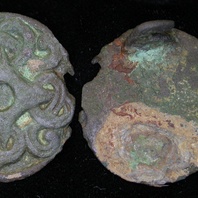
Viking Objects
Copper-Alloy Disc Brooch (LEIC-782CD2)
This Anglo-Scandinavian copper-alloy disc brooch has small traces of silvering on both surfaces. It is decorated in Borre-style interlaced knotwork matching the East Anglian type II. For more information on Scandinavian jewellery in England check out our blog: Brooches, Pendants and Pins: Scandinavian Dress Accessories in England.
Read More
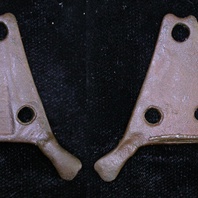
Viking Objects
Stirrup Mount (LEIC-AF8883)
This copper-alloy stirrup-strap mount is decorated with an unusual geometric pattern with incised lines running across its surface. It has been classified as a Williams Class A Type 8, but is probably a hybrid.
Read More
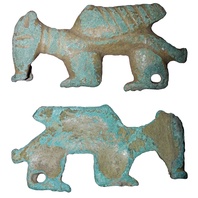
Viking Objects
Scabbard Fitting (LIN-3DE8C7)
This chape, proabably meant for a knife scabbard, has an openwork abstract zoomorphic form representing a winged beast in profile.
Read More
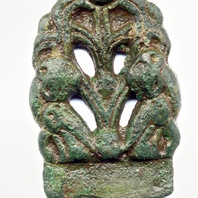
Viking Objects
Anglo-Scandinavian Strap-End (LEIC-0C2B81)
This example of an Anglo-Scandinavian copper-alloy strap-end displays foliate decoration and features a mixture of the Anglo-Saxon Winchester style and Anglo-Scandinavian zoomorphic heads. It is classified as Thomas Class E, Type 1.
Read More
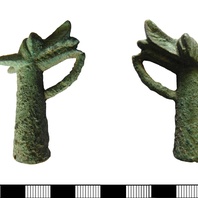
Viking Objects
Drinking-Horn Terminal (LIN-F0DD46)
This probable drinking horn terminal has a hollow conical socket with three rivet-holes at the attachment end. The socket is ribbed and at the top it has an integral animal head in the form of a mythical creature, most likely a dragon.
Read More
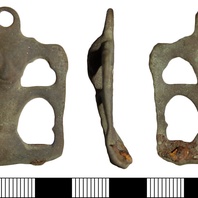
Viking Objects
Stirrup-Strap Mount (BH-D273BF)
This copper-alloy stirrup strap mount is classed as a Williams Class B Type 2 and is decorated with an openwork zoomorphic design.
Read More
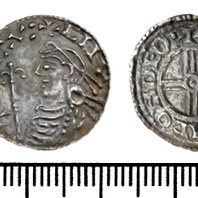
Viking Objects
Coin of Cnut the Great (LEIC-4B7888)
This Short Cross Type silver penny was minted in the name of King Cnut between 1024 and 1030 in the Derby mint by the moneyer Swartinc. The location of discovery is unknown. Minting coins was a way of controlling the means of exchange within a kingdom and which created a more easily administered standardized system of trade. Moreover, the coins themselves were often used as propaganda, portaying symbols and statements that gave off a desired message. The Vikings later used the minting of coins to legitimize their own rule.
Read More
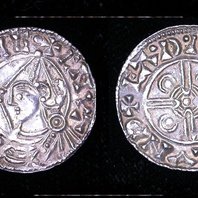
Viking Objects
Coin of Cnut the Great (LEIC-3E8CC4)
This silver Helmet IIIc Type penny was minted for King Cnut of England in London. The obverse inscription reads CNVTREXANG while the obverse reads EADPOLD ON LVND. Minting coins was a way of controlling the means of exchange within a kingdom and which created a more easily administered standardized system of trade. Moreover, the coins themselves were often used as propaganda, portaying symbols and statements that gave off a desired message. The Vikings later used the minting of coins to legitimize their own rule.
Read More
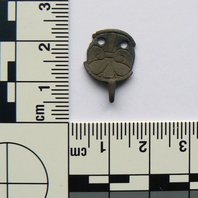
Viking Objects
Hooked Tag (PUBLIC-6847A6)
This hooked tag is constructed from a circular plate and single hook. The decoration features a trefoil with fillet design on the front probably influenced by the Ringerike style.
